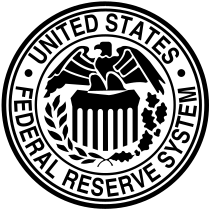Eugene Robert Black
Eugene Robert Black I (January 7, 1873 – December 19, 1934) was the Chairman of the Federal Reserve from May 9, 1933 to August 15, 1934.[1]
Eugene Black | |
|---|---|
.jpg) | |
| 6th Chair of the Federal Reserve | |
| In office May 19, 1933 – August 15, 1934 | |
| President | Franklin Roosevelt |
| Preceded by | Eugene Meyer |
| Succeeded by | Marriner Eccles |
| Member of the Federal Reserve Board of Governors | |
| In office May 19, 1933 – August 15, 1934 | |
| President | Franklin Roosevelt |
| Preceded by | Eugene Meyer |
| Succeeded by | Marriner Eccles |
| President of the Federal Reserve Bank of Atlanta | |
| In office August 15, 1934 – December 19, 1934 | |
| Preceded by | W. S. Johns |
| Succeeded by | Oscar Newton |
| In office January 13, 1928 – May 19, 1933 | |
| Preceded by | Max Wellborn |
| Succeeded by | W. S. Johns |
| Personal details | |
| Born | January 7, 1873 Atlanta, Georgia, U.S. |
| Died | December 19, 1934 (aged 61) Atlanta, Georgia, U.S. |
| Education | University of Georgia (BA) Atlanta Law School (LLB) |
Biography
He was born in Atlanta, Georgia on January 7, 1873.
He attended the University of Georgia, where he was a member of the Chi Phi Fraternity and the Phi Kappa Literary Society.
In 1897, he married the daughter of Henry W. Grady, the Atlanta journalist and orator. They had a son, Eugene Robert Black II.[2]
Black practiced law for 28 years until he became president of the Atlanta Trust Company in 1921, and in 1928, he became Governor of the Federal Reserve Bank of Atlanta. He succeeded the longtime governor, Max Wellborn, who was also his daughter's father-in-law. When the Wall Street Crash of 1929 happened, he and two cashiers rushed to Nashville, Tennessee to supply currency and credit to banks in the city and surrounding region. The situation worsened with other cities in the region experiencing bank runs. Black kept his district afloat by rushing large quantities of cash to banks that were experiencing runs and extending credit to any bank that could offer any asset of value. He kept this policy active through the Great Depression into 1933. He, along with George L. Harrison, the Governor of the Federal Reserve Bank of New York, recommended open market purchases to increase reserves. His insistence on expansionist policies led to the President appointing Black as chairman of the Federal Reserve Board of Governors in 1933.[3]
He died of a heart attack on December 19, 1934 in Atlanta, Georgia.[1]
References
- "Eugene Black Dies Of Heart Attack. Governor of Federal Reserve Guided System in Nation's Critical Era of Finance. President's Close Friend. 'Depositors Owe Much to You,' Roosevelt Wrote When He Quit Post Aug. 15". The New York Times. December 20, 1934.
- Eugene "Gene" Robert Black, Sr., was the first in the family to use the "Sr." designation; his son was known as Eugene Robert Black, Jr. or Eugene Robert Black III.
- Richardson, Gary; Troost, William (May 2005). "Monetary Intervention Mitigated Banking PanicsDuring the Great Depression" (PDF). Archived from the original (PDF) on September 27, 2006. Retrieved August 23, 2006.
Further reading
- Meltzer, Allan H. (2003). A History of the Federal Reserve – Volume 1: 1913–1951. Chicago: University of Chicago Press. pp. 240–499. ISBN 978-0226520001.
External links
| Government offices | ||
|---|---|---|
| Preceded by Eugene Meyer |
Chair of the Federal Reserve 1933–1934 |
Succeeded by Marriner Eccles |
